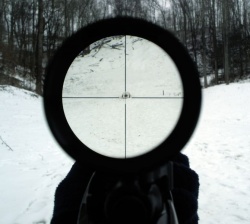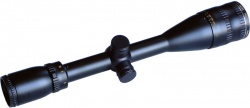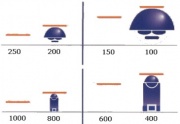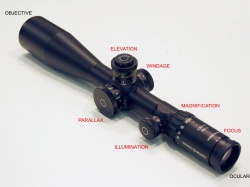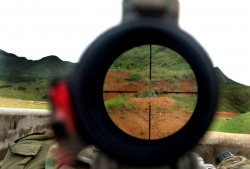Telescopic sight
A telescopic sight, commonly called a scope, is a device used to give additional accuracy using a point of aim for weapons such as firearms, airguns and crossbows. Other sighting systems are iron sights, red dot sights, and laser sights.
This article will concentrate on firearm scopes; the principles described are equally applicable to any device which needs aiming. For the sake of brevity, the term gun will be used to indicate any device aimed by a telescopic sight.
Contents |
[edit] Types
Telescopic sights are classified in terms of the optical magnification and the objective lens diameter, e.g. 10×50. This would denote 10 times magnification with a 50 mm objective lens. In general terms, larger objective lens diameters are better (collect more light and give a wider field of view), the magnification power should be chosen on the basis of the intended use. There are also adjustable objectives sights where the magnification can be changed by manually turning one part; the syntax is the following: minimal magnification — maximum magnification × objective lens, for example, 3–9×40.
Confusingly, some older telescopic sights, mainly of German or other European manufacture, have a different classification where the second part of the designation refers to 'light gathering power', therefore in these cases a 4×81 (4× magnification) sight would be presumed to have a brighter sight picture than a 2.5×70 (2.5× magnification), but the objective lens diameter would not bear any direct relation to picture brightness, as brightness is affected also by the magnification factor. Typically objective lenses on early sights are smaller than modern sights, in these examples the 4×81 would have an objective approximately 32mm diameter and the 2.5×70 might be approximately 25mm.
[edit] Reticles
Telescopic sights come with a variety of different reticles, ranging from the traditional crosshairs to complex reticles designed to allow the shooter to estimate accurately the range to a target, to compensate for the bullet drop, and to compensate for the windage required due to crosswinds. A user can estimate the range to objects of known size, the size of objects at known distances, and even roughly compensate for both bullet drop and wind drifts at known ranges with a reticle-equipped scope.
For example, with a typical Leupold brand duplex 16 MOA reticle (of a type as shown in image B) on a fixed power scope, the distance from post to post (that is, between the heavy lines of the reticle spanning the center of the scope picture) is approximately 32 inches (81.3 cm) at 200 yards (183 m), or, equivalently, approximately 16 inches (40.65 cm) from the center to any post at 200 yards. With a known target of a diameter of 16 inches that fills just half the distance from scope center to post, the distance to target is approximately 200 yards (183 m). With a known target of a diameter of 16 inches that fills the entire sight picture from post to post, the range is approximately 100 yards. Other ranges can be similarly estimated accurately in an analog fashion for known target sizes through proportionality calculations. Holdover, for estimating vertical point of aim offset required for bullet drop compensation on level terrain, and horizontal windage offset (for estimating side to side point of aim offsets required for wind effect corrections) can similarly be compensated for through using approximations based on the wind speed (from observing flags or other objects) by a trained user through using the reticle marks. The less-commonly used holdunder, used for shooting on sloping terrain, can even be estimated by an appropriately-skilled user with a reticle-equipped scope, once the slope of the terrain and the slant range to target are both known.
There are two main types of reticles:
- Wire reticles
- Etched reticles
Wire reticles are the oldest type of reticles and are made out of metal wire. They are mounted in an optically appropriate position in the telescopic sight's tube. Etched reticles are images of the desired reticle layout that are etched on an optic element. This optical element (lens) with the etched reticle is then mounted in the telescopic sights tube as an integrated part of the optics chain of the sight. When backlit through the ocular a wire reticle will reflect incoming light and not present a black contrasty reticle. An etched reticle will stay black if backlit. Etched reticles are by most considered to be a more refined solution and offer greater reticle lay out flexibility. Because of this some manufacturers can provide client designed custom reticles on special order. In the more expensive and high end contemporary telescopic sights etched reticles dominate the market. In cheaper telescopic sights wire reticles are still often mounted to avoid a rather specialized and costly production step.
[edit] Mil-dot reticles
Modern military and law enforcement reticles are generally designed for (stadiametric) rangefinding purposes. Perhaps the most flexible ranging reticle is the "Mil-dot" reticle, which consists of duplex crosshairs with small dots at milliradian (Mil) intervals in the field of view. A milliradian equates to 3.43774677078493 MOA, that is, approximately 21.6 inches at 600 yards; each MOA equates to 1.0471975511966 inch at 100 yards, often rounded to 1 inch at 100 yards for fast mental calculations.
Users who use the metric system are better off with a Mil-dot reticle, since they do not have to hassle with the unnecessary complications of a non metric system of measurement during mental calculations. Also the Mil-dot measurements and ranging calculations are always exact in the metric system.
A trained user can relatively accurately measure the range to objects of known size, the size of objects at known distances, and compensate for both bullet drop and wind drifts at known ranges with a Mil-dot reticle-equipped scope.
This is what a Netherlands Army sniper sees through his Schmidt & Bender 3-12x50 PM II[1] telescopic sight. The Mil-dots can be seen on the cross hairs. By means of a mathematical formula - (size target / number of mil of dots) x 1000 = distance - the user can measure the range to a target. An object of 1 meter tall is exactly 1 Mil tall at 1000 meters distance. If the user sees an object of 1.8 m tall for example as three mil dots tall through the riflescope the object is at 600 m distance - (1.8 / 3) * 1000 = 600.
The four horizontal bars over the horizontal line are also intended for (quick) ranging purposes.
[edit] Reticle focal plane
The reticle may be located at the front or rear focal plane (First Focal Plane (FFP) or Second Focal Plane (SFP)) of the telescopic sight. On fixed power telescopic sights there is no significant difference, but on variable power telescopic sights the front plane reticle remains at a constant size compared to the target, while rear plane reticles remain a constant size to the user as the target image grows and shrinks. Front focal plane reticles are slightly more durable, but most American users prefer that the reticle remains constant as the image changes size, so nearly all modern variable power telescopic sights are rear focal plane designs. European high end optics manufacturers often leave the customer the choice between a FFP or SFP mounted reticle.
Variable power telescopic sights with front focal plane reticles have no problems with point of impact shifts. Variable power telescopic sights with rear focal plane reticles can have slight point of impact shifts through their magnification range caused by the positioning of the reticle in the mechanical zoom mechanism in the rear part of the telescopic sight. Normally these impact shifts are insignificant but make accuracy orientated users, that wish to use their telescopic sight trouble-free at several magnification levels, often opt for front focal plane reticles. Around the year 2005 Zeiss[2] was the first high end European telescopic sight manufacturer who brought out variable magnification military grade telescopic sight models with rear focal plane mounted reticles. They get around impermissible impact shifts for these sights by laboriously hand adjusting every military grade telescopic sight. The American high end telescopic sight manufacturer U.S. Optics Inc. [3] also offers variable magnification military grade telescopic sight models with rear focal plane mounted reticles.
[edit] Reticle illumination
Either type of reticle can be illuminated for use in low light conditions. With any illuminated reticle, it is essential that its brightness can be adjusted. A reticle that is too bright will cause glare in the operator’s eye, interfering with his ability to see in low-light conditions. This is because the pupil of the human eye closes quickly upon receiving any source of light. Most illuminated reticles provide adjustable brightness settings to adjust the reticle precisely to the ambient light.
Illumination is usually provided by a battery powered LED, though other electric light sources can be used. The light is projected forward through the scope, and reflects off the back surface of the reticle. Red is the most common colour used, as it least impedes the shooter's night vision.
Radioactive isotopes can also be used as a light source, to provide an illuminated reticule for low-light condition aiming. In sights like the SUSAT or Elcan C79 Optical Sight tritium-illuminated reticles are used for low-light condition aiming. Trijicon Corporation uses tritium in their combat and hunting-grade firearm optics, including the ACOG. The (radioactive) tritium light source has to be replaced every 8-12 years, since it gradually loses its brightness due to radioactive decay.
[edit] Parallax compensation
Parallax problems result from the image from the objective not being coincident with the reticle. If the image is not coplanar with the reticle (that is the image of the objective is either in front of or behind the reticle), then putting your eye at different points behind the ocular causes the reticle crosshairs to appear to be at different points on the target. This optical effect causes parallax induced aiming errors that can make a telescopic sight user miss a small target at a distance where the telescopic sight was not parallax adjusted for.
To eliminate parallax induced aiming errors, telescopic sights can be equipped with a parallax compensation mechanism which basically consists of a movable optical element that enables the optical system to project the picture of objects at varying distances and the reticle crosshairs pictures together in exactly the same optical plane. There are two main methods to achieve this.
- By making the objective lens of the telescopic sight adjustable so the telescopic sight can compensate parallax errors. These models are often called AO or A/O models, for adjustable objective.
- By making an internal lens in the internal optical groups mounted somewhere in front of the reticle plain adjustable so the telescopic sight can compensate parallax errors. This method is technically more complicated to build, but generally more liked by parallax adjustable telescopic sight users—unlike AO models, which are read from the top, the sidewheel's setting can be read with minimal movement of the head. These models are often called side focus or sidewheel models[4].
Most telescopic sights lack parallax compensation because they can perform very acceptably without this refinement. Telescopic sights manufacturers adjust these scopes at a distance that best suits their intended usage. Typical standard factory parallax adjustment distances for hunting telescopic sights are 100 yd or 100 m to make them suited for hunting shots that rarely exceed 300 yd/m. Some target and military style telescopic sights without parallax compensation may be adjusted to be parallax free at ranges up to 300 yd/m to make them better suited for aiming at longer ranges[5]. Scopes for rimfires, shotguns, and muzzleloaders will have shorter parallax settings, commonly 50 yd/m[6] for rimfire scopes and 100 yd/m[7] for shotguns and muzzleloaders. Scopes for airguns are very often found with adjustable parallax, usually in the form of an adjustable objective, or AO. These may adjust down as far as 3 yards (2.74 m)[8].
The reason why scopes intended for short range use are often equipped with parallax compensation is that at short range (and at high magnification) parallax errors become more noticeable. A typical scope objective has a focal length of 100 mm. An optical ideal 10x scope in this example has been perfectly parallax corrected at 1000 m and functions flawlessly at that distance. If the same scope is used at 100 m the target-picture would be projected (1000 m / 100 m) / 100 mm = 0.1 mm behind the reticle plain. At 10x magnification the error would be 10 * 0.1 mm = 1 mm at the ocular (eyepiece). If the same scope was used at 10 m the target-picture would be (1000 m / 10 m) / 100 mm = 1 mm projected behind the reticle plain. When 10x magnified the error would be 10 mm at the ocular.
[edit] Bullet Drop Compensation
Bullet Drop Compensation (BDC) is a feature available on some rifle scopes (sometimes referred to as ballistic elevation). The feature compensates for the effect of gravity on the bullet at given distances (referred to as "bullet drop"). The feature must be tuned for the particular ballistic trajectory of a particular combination of rifle and cartridge at a predefined air density. Inevitable BDC induced errors will occur if the environmental and meteorological circumstances deviate from the circumstances the BDC was calibrated for. Marksmen can be trained to compensate for these errors.
[edit] Adjustment controls
A telescopic sight can have several adjustment controls.
- Focusing control at the ocular end of the sight - meant to obtain a sharp picture of the object and reticle.
- Elevation or vertical adjustment control of the reticle.
- Windage or horizontal adjustment control of the reticle.
- Magnification control - meant to change the magnification by turning a ring that is generally marked with several magnification power levels.
- Illumination adjustment control of the reticule - meant to regulate the brightness level of the lit parts of the reticles crosshairs.
- Parallax compensation control.
Most contemporary telescopic sights offer the first three adjustment controls. The other three are found on telescopic sights that offer a variable magnification, an illuminated reticle and/or parallax compensation. A rather common problem with the elevation and windage adjustment controls is that once smooth working adjustment turrets ‘get stuck’ over the years. This is generally caused by long time lack of movement in the lubricated turret mechanisms.
Older telescopic sights often did not offer windage and elevation adjustments in the scope, but rather used adjustable mounts to provide adjustment. Some modern mounts also allow for adjustment, but it is generally intended to supplement the scope adjustments. For example, some situations require fairly extreme elevation adjustments, such as very short range shooting common with airguns, or very long range shooting, where the bullet drop becomes very significant. In this case, rather than adjusting the scope to the extremes of its elevation adjustment, the scope mount can be adjusted. This allows the scope to operate near the center of its adjustment range. Some companies offer adjustable bases, while others offer bases with a given amount of elevation built in. The adjustable bases are more flexible, but the fixed bases are more durable, as adjustable bases may loosen and shift under recoil[9][10].
[edit] Accessories
Typical accessories for telescopic sights are:
- Lens hoods for mounting on the objective and/or ocular to reduce/eliminate image quality impairing stray light.
- Lens hoods that extend the full length of a gun barrel to improve image quality by blocking out shot strings induced mirage.
- Kill Flash filters to eliminate light reflections from the objective that could compromise a sniper.
- Eye safe laser filters to protect operators against being wounded/blinded by laser light sources.
[edit] Optronic technologies
In 1997 Swarovski introduced the LRS series telescopic sight, the first riflescope on the civilian market with an integrated laser rangefinder. The Swarovski LRS 2-12x50 can measure ranges up to 600 m (660 yd). Around 2006 Zeiss also introduced a telescopic sight in their sports optics range with an integrated laser rangefinder. This Victory Diarange scopes can measure ranges from 10 m (10.9 yd) up to 999 m (1092.5 yd).
Zeiss also offers in its defense optics range the 6-24x72 SAM telescopic sight. The SAM (Shooter-supporting Attachment Module) module measures and provides aiming and ballistic relevant data and displays this to the user in the ocular.
Barrett has developed an integrated ballistic computer/riflescope system known as Barrett Optical Ranging System (BORS). The BORS module is in essence an electronic Bullet Drop Compensation (BDC) sensor/calculator package intended for long-range sniping out to 2500 m (2734 yd) for some telescopic sight models made by Leupold. To establish the appropriate elevation setting the shooter needs to enter the ammunition type into the BORS (using touch pads on the BORS console) determine the range (either mechanically or through a laser rangefinder) and crank the elevation knob on the scope until the proper range appears in the BORS display. The BORS automatically determines the air density, as well as the cant or tilt in the rifle itself, and incorporates these environmental factors into its elevation calculations.[11] Barrett intends to develop an improved version (new optics, Night Vision capable, wide angle, stabilized image) of BORS.
ELCAN produces the DigitalHunter Digital Rifle Scope series that combines CCD and LCD technology with electronic ballistics compensation, automatic video capture, 4 field selectable reticles and customizable reticles.
[edit] Mounting
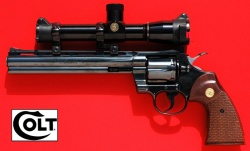
As very few firearms come with built-in telescopic sights (military bullpup designs such as the Steyr AUG being the primary exception) mounting a scope to a firearm requires additional equipment. Equipment is available to mount scopes on most production firearms. A typical scope mounting system consists of two parts, the scope base and the scope rings. By picking the appropriate combination of scope base to fit the firearm and scope rings to fit the scope, a wide range of scopes may be mounted to most firearms. With the appropriate combination of adjustable scope bases and scope rings it is also possible to mount several telescopic sights on the same gun to make the gun more versatile. However, it is important to take into consideration whether or not a gun is particularly hard to mount. If it is or if a gun is intended for long-range shooting, it could be that the amount of vertical adjustment range is smaller than required. This can be solved with the help of a vertically canted base or canted rings. Typical cant angles offered by mounting components manufacturers are 20 and 30 MOA. It is always wise to buy telescopic sights that provide a decent adjustment range, preferably at least 60 MOA or more [12].
[edit] Scope bases
The base is attached to the rifle, usually with screws, and is often designed to have a low profile, and to allow use of the iron sights if the scope is not present. Some manufacturers provide integral bases on many of their firearms; an example of such a firearm is the Ruger Super Redhawk revolver. The most commonly encountered mounting systems are the 3/8 inch (9.5 mm) and the 11 mm dovetail mounts (sometimes called tip-off mounts), commonly found on rimfires and air guns, the Weaver type base and the STANAG 2324 (MIL-STD-1913 "Picatinny rail") base. Ruger uses a proprietary scope base system, though adapters are available to convert the Ruger bases into Weaver type bases. Scope base and mounting systems are also manufactured in Europe. Specialized manufacturers like Ernst Apel GmbH[13] [14] offer an elaborate program of mounting solutions for lots of different guns. Some of the European mounting solutions are virtually unknown and hence rarely applied in America. Many European gun manufacturers also developed and offer proprietary scope base systems for their guns.
[edit] Scope rings
In addition to needing the right type of connector to attach to the desired base, scope rings must be used to hold the scope to the mount. The rings must be of the proper size to fit the scope; common sizes are 3/4 inch (19.05 mm), 22 mm, 1 inch (25.4 mm), 26 mm, 30 mm and 34 mm. Red dot sights commonly are found in larger sizes, such as 40 mm, and these often use ringless mounting systems designed to fit dovetail or Weaver type bases. Rings are also available in a variety of heights and materials. Ring height is chosen to place the scope high enough to clear the firearm, and at a height comfortable for the shooter.
[edit] Scope mounting rails

European telescopic sight manufacturers often offer the option to have mounting rails underneath the riflescope to provide for mounting solutions that do not use scope rings or a single scope ring around the objective of the scope. These rails are an integral part of the scope body and can not be removed. The mounting rail permits the riflescope to be securely and tension-free mounted at the preferred height and correct distance from the shooter's eye and on different guns.
There are several mounting rail systems offered:
- Standard prism
- Zeiss ZM/VM, also used by Doctor
- Swarovski Optics SR
- Schmidt & Bender Convex
The traditional standard prism mounting rail system requires to have the scope rail drilled from the side for fixture screws. The more recent propriety systems mainly offer aesthetic advantages for people who have problems with redundant drill holes in sight in case the riflescope is used on different guns. To avoid drilling the scope rail, the propriety rail mounting systems have special shape connections machined in the inside of the rail. These shape connections prevent ever showing any exterior damage from mounting work on the rifle scope. The propriety rail systems use matching slide-in mount fasteners to connect the riflescope to the gun. Some propriety rails also offer the possibility to tilt the scope up to 1° to the left or right.
[edit] Mounting issues
Scopes for use on light recoiling firearms, such as rimfire guns, can be mounted with a single ring, and this method is not uncommon on handguns, where space is at a premium. Most scopes are mounted with two rings, one in the front half of the scope and one on the back half, which provides additional strength and support. The heaviest recoiling firearms, such as Thompson Center Arms Contender pistols in heavy recoiling calibers, will use three rings for maximum support of the scope. Use of too few rings can result not only in the scope moving under recoil, but also excessive torque on the scope tube as the gun rolls up under recoil.
Scopes on heavy recoiling firearms and spring piston airguns (which have a heavy "reverse recoil" caused by the piston reaching the end of its travel) suffer from a condition called scope creep, where the inertia of the scope holds it still as the firearm recoils under it. Because of this, scope rings must be precisely fitted to the scope, and tightened very consistently to provide maximum hold without putting uneven stress on the body of the scope. Rings that are out of round, misaligned in the bases, or tightened unevenly can warp or crush the body of the scope.[15]
Another problem is mounting a scope on a rifles, such as some lever action designs, where the shell is ejected out the top of the rifle. Usually this results in the scope being offset to one side (to the left for right-handed people, right for left-handed) to allow the shell to clear the scope. Alternately a scout rifle type mount can be used, which places a long eye relief scope forward of the action.
A firearm may not always be able to fit all aiming optics solutions, so it is wise to have a preferred aiming optics solution first reviewed by a professional.
[edit] Uses
Telescopic sights have both advantages and disadvantages relative to iron sights. Standard doctrine with iron sights is to focus the eye on the front sight and align it with the resulting blur of the target and the rear sight; most shooters have difficulty doing this, as the eye tends to be drawn to the target, blurring both sights. Gun users over 30 years of age with keen eyesight will find it harder to keep the target, front sight element and rear sight element well enough into focus for aiming purposses as human eyes gradually lose focussing flexibility with rising age. Telescopic sights allow the user to focus on both the crosshair and the target at the same time, as the lenses project the crosshair into the distance (50 m or yd for rimfire scopes, 100 m or yd more for centerfire calibers). This, combined with telescopic magnification, clarifies the target and makes the target stand out against the background. The main disadvantage of magnification is that the area to either side of the target is obscured by the tube of the sight. The higher the magnification, the narrower the field of view in the sight, and the more area that is hidden. Rapid fire target shooters use red dot sights, which have no magnification; this gives them the best field of view while maintaining the single focal plane of a telescopic sight. Telescopic sights are expensive, and require additional training to align. Sight alignment with telescopic sights is a matter of making the field of vision circular to minimize parallax error.
[edit] Military use
Until the 1990s, military use of telescopic sights was restricted to snipers because of the fragility and expense of optical components, though they had been used as early as the American Civil War on rifles, and even earlier for other jobs. The glass lenses are prone to breakage, and environmental conditions such as condensation, precipitation, dirt, and mud obscure external lenses. The scope tube also adds significant bulk to the rifle. Snipers generally used moderate to high magnification scopes with special reticles that allow them to estimate range to the target.
Telescopic sights provide some tactical disadvantages. Snipers rely on stealth and concealment to get close to their target. A telescopic sight can hinder this because sunlight may reflect from the lens and a sniper raising his head to use a telescopic sight might reveal his position. The famous Finnish sniper Simo Häyhä preferred to use iron sights rather than telescopic sights to present less of a target. Harsh climate can also cause problems for telescopic sights as they are less rugged than iron sights. Many Finnish snipers in WWII used iron sights heavily because telescopic sights did not cope with very cold Finnish winters.
The market for military telescopic sights intended for military long-range shooting is highly competitive. Several high end optics manufacturers are constantly adapting and improving their telescopic sights to fulfill specific demands of military organizations. Two European companies that are active this field are Schmidt & Bender and Zeiss/Hensoldt. American companies that are also very active in this field are Nightforce and U.S. Optics Inc. These high end sighting components generally cost € 1500 / $ 2000 or more. Typical options for military telescopic sights are reticle illumination for use under adverse light circumstances and the presentation of scope settings or ballistic relevant environmental measurements data to the operator through the sights ocular. Military organizations also are a main driving force behind the development of ever more versatile mil-dot reticles, like the Generation II mil-dot reticle from Premier Reticles[16] the US Marine Corps specified for their 7000 USMC M8541 Premier/Schmidt & Bender 3-12x50 PM II LP telescopic sights. Other range finding reticle variations like Schmidt & Bender's P4-fine reticule, which uses mil-hash marks instead of mil-dots for ranging purposes, also were developed on request of active snipers and other long-range field shooters.
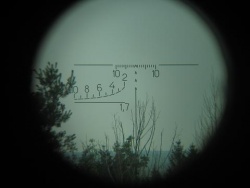
The former Warsaw Pact members produce military telescopic sights for their designated marksmen and developed a range finding reticle based on the height of an average human. The reticle used in the Romanian I.O.R. LPS 4x6° TIP2 4x24 rifle scope is calibrated for ranging a 1.7 m tall target from 200 m to 1000 m. This Romanian scope shares the basic design and stadiametric rangefinder found in the reticle of the original Russian PSO-1 and POSP scope series. The target base has to be lined up on the horizontal line of the range-finding scale and the target top point has to touch the upper (dotted) line of the scale without clearance. The digit under which this line up occurs determines the distance to the target.
The Israeli military began widespread use of telescopic sights by ordinary infantrymen to increase hit probability (especially in dim light) and extend effective range of standard issue infantry rifles. Palestinian militants in the al Aqsa Intifada likewise found that adding an inexpensive scope to an AK-47 increased its effectiveness.
Today, several militaries issue telescopic sights to their infantry, usually compact, low-magnification sights suitable for snap-shooting, like red dot sights. American GIs in Iraq frequently purchase their own and carry them from home. The British army fields the SA80 rifle with the SUSAT 4× optical sight as standard issue. The Canadian Forces standard C7 rifle has a 3.4 Elcan C79 optical sight. Both Austria and Australia field variants of the Austrian Steyr AUG which has built an integral 1.5x optical sight since its deployment in the late 1970s, and the German Army's G36 has a more or less built in 3.0× optical sight, as well as a red dot sight with no magnification.
[edit] See also
[edit] References
- ↑ Schmidt & Bender 3-12x50 PM II
- ↑ Zeiss: Telescopic sights for handheld weapons
- ↑ U.S. Optics Inc.
- ↑ BSA side wheel focus riflescopes
- ↑ Schmidt & Bender PM II specs
- ↑ BSA rimfire scopes
- ↑ BSA shotgun/muzzleloader scope
- ↑ Leapers 3-9x32 Mini Mil-Dot Illuminated AO Scope (SCP-M392AOMDL), parallax adjustable from 3 yards to ∞
- ↑ Mac 1 Airgun "drooper" mounts
- ↑ Pyramid Air article on adjustable scope bases
- ↑ Barrett BORS Manual
- ↑ Guide for Tactical and Rifle Scopes (Tips and Considerations)
- ↑ EAW scope mounts
- ↑ EAW mounts catalog
- ↑ High-speed video of a Schmidt & Bender PMII telescopic sight, mounting and barrel flexing on a .50 BMG Accuracy International AS50.
- ↑ Premier Reticles
[edit] External links
- demigodllc.com: PRACTICAL LONG-RANGE RIFLE SHOOTING - Part II: Optics by Zak Smith
- demigodllc.com: Introduction to High-End Long-Range Rifle Scopes by Zak Smith
- MILS and MOA - A Comprehensive Manual to Understanding: types of "Mils", types of Minute of Angle (moa), the Derivation of The Range Estimation Equations by Robert J. Simeone
